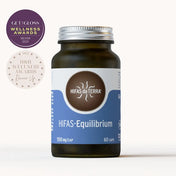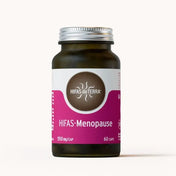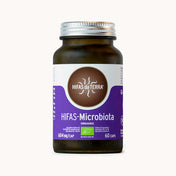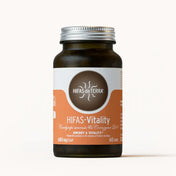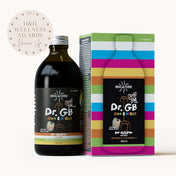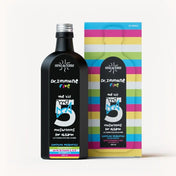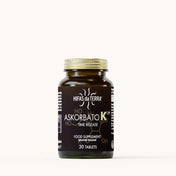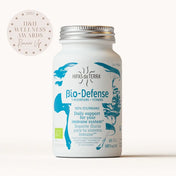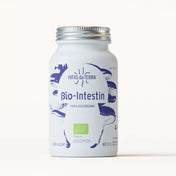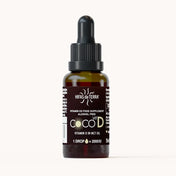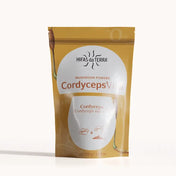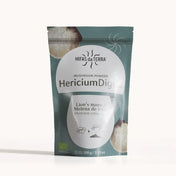Food supplements based on medicinal mushrooms are attracting growing interest. Reishi, Lion's Mane, Chaga, Cordyceps… These names, once familiar only to connoisseurs, now resonate far beyond thanks to a piece of booming scientific news. Mycotherapy – which consists of using bioactive molecules from mushrooms for health purposes – has established itself as a major asset in the world of food supplements.
Yet, behind this craze, a challenge arises: deciphering labels and understanding the terminology that oscillates between technicality and marketing. Terms such as “ Full Spectrum ”, “ biomass ”, “ mycelium ”, or even “ primordia ” often appear without any real explanation being provided. Behind certain expressions lie practices that harm the quality of the product, thus misleading the consumer about the real value of their purchase.
Why this article? Because at Hifas da Terra, we firmly believe that the power of mushrooms lies above all in their quality, their production method and their precise composition. Our mission is therefore to provide you with the keys to decipher this jungle of terms and allow you to distinguish a good supplement from a product that focuses more on marketing than on effectiveness.
Deciphering the terminology specific to mycotherapy
To navigate the ocean of mushroom supplements without fear, as with navigation, you need to know the terms.
These names, sometimes legitimate, sometimes marketing can influence our choices, often without us understanding what they imply. In this section, we decipher the jargon surrounding medicinal mushroom supplements.
“Full Spectrum” – A concept full of ambiguities
Let’s start with a phrase you may have seen on labels before: “ Full Spectrum .”
In its rigorous definition, a “Full Spectrum” extract should include all the bioactives of the mushroom, water-soluble (extracted by hot water) and fat-soluble (extracted by alcohol). This process ensures maximum bioavailability by eliminating chitin, an indigestible component that traps these bioactives in the cell walls.
However, some producers use this term to refer to mixtures of mycelium, substrate, and sporophore, thereby diluting the concentration of bioactive and deviating from the idea of a true “full spectrum”. These products, while appealing in theory, often offer little benefit.
At this point, you may still think that this is not a bad product, but understand that when the mushroom is grown on a solid substrate, the substrate occupies a – very – important place in what is harvested.
“Biomass” – A composition to examine closely
“Biomass” generally refers to all the elements produced during a mushroom's growth cycle.
However, it is crucial to note that the biomass frequently includes the substrate (grains, cereals, etc.) not fully digested by the fungus. This means that a significant portion of the final product may consist of starch, diluting the proportion of active compounds such as beta-glucans and triterpenes.
But why to integrate starch into products, you might ask? Because starch is a polysaccharide, just like… ß -1,3/1,6-D-glucans ! There’s nothing like a product full of starch to artificially inflate the levels present in the product, especially since cereal is much less expensive and easier to produce.
Is it possible to determine the composition before buying? Not really, but a quick test allows you to check whether or not there is starch in the capsules. We tried it at Hifas if you want to take a look!
“Mycelium” – The challenge of cultivation and transformation
Mycelium, often described as the “root” part of the mushroom, is a network of filaments that absorbs nutrients to fuel growth. Although rich in interesting secondary compounds, mycelium grown on grain (MOG) often contains large amounts of undigested grain residue.
This production method can result in a final product containing more carbohydrates than mushroom-specific bioactives. This is why it is essential to favour extracts from pure mycelium (grown in a bioreactor) or fruiting bodies (also called sporophores).
“Sporophore” – The star of quality supplements
The sporophore, the visible and harvested part of the mushroom, is usually the peak in terms of concentration of bioactives . This is where triterpenes are found in Reishi, or cordycepin in Cordyceps.
These are also, in most cases, the only parts of the mushroom allowed in food supplements.
However, some mushrooms, such as Chaga, contradict this rule: their active compounds develop mainly in the mycelial mass resulting from their fight against the host (birch, in this case).
Extraction methods: what do they mean?
The effectiveness of Mycotherapy is partly based on the extraction method used. Indeed, the bioactives contained in mushrooms ( beta-1,3/1,6-D-glucans, triterpenes, and other specific compounds ) are often enclosed in chitin, an insoluble fibre that is difficult for the human body to digest. Extraction releases these compounds and makes them bioavailable. Each method has its advantages and limitations, but their choice depends on the type of mushroom and the targeted benefits.
Here is an overview of the main extraction methods that you can find among operators in the sector.
- Single Extraction: Hot Water or Alcohol This method relies on the use of a single solvent: hot water or alcohol. Hot water is effective for extracting water-soluble compounds such as beta-glucans, while alcohol targets fat-soluble compounds, such as triterpenes. However, each solvent limits the range of compounds obtained, sometimes making the extract incomplete.
- Dual Extraction: Hot Water + Alcohol This method combines two solvents to extract both water-soluble and fat-soluble compounds. It ensures optimal bioavailability and preservation of active compounds, providing a full spectrum of bioactives. Although more expensive, it is a quality standard in the industry.
- Ultrasonic extraction Innovative, this technique uses ultrasonic waves to release active compounds by breaking the cell walls of fungi. It is fast, preserves heat-sensitive compounds, but sometimes requires additional processing to isolate certain bioactives.
- Fermentation extraction This biological method stimulates the fungi to produce more secondary compounds before extraction, such as cordycepin in Cordyceps. Although effective for some metabolites, it is time-consuming, expensive, and less suitable for some fungi.
- Simple maceration extraction Traditional, this technique involves prolonged immersion in a solvent such as water or alcohol. It is gentle and inexpensive, but less effective at extracting compounds locked in the chitin of mushrooms.
UP TO YOU !
Now that you have the keys to analyzing functional mushroom product labels, let's get down to business! Below are three examples of products with the information displayed on their labels. Which of them stands out in terms of quality? Why? Take a moment to think about your answer, then check your conclusions a little further down.
This is the perfect opportunity to put your new skills into practice and become an informed consumer in the field of Mycotherapy! 🍄

Product #1
- Positive points: Double extraction, which allows better recovery of water-soluble and fat-soluble compounds.
- Weaknesses: The “Full Spectrum” label is ambiguous and could indicate the presence of substrate (grain or other). In addition, the lack of details on the bioactive molecules present prevents the therapeutic quality of the product from being assessed.
Product #2
- Pros: Simple alcohol extraction, useful for isolating certain compounds like triterpenes.
- Weaknesses: Does not include ß-1,3/1,6-D-glucans, key molecules for Mycotherapy. The mention of “biomass” also suggests the presence of unnecessary substrate.
Product #3
- Pros: Uses 100% concentrated mycelium extract, with a method that preserves and optimizes bioactive molecules.
- Weak points: No indication of the content of bioactive molecules on the labelling. Without this information, it is impossible to verify whether we are indeed in the presence of a Mycotherapy product. Furthermore, this product is prohibited! Because Cordyceps militaris is not authorized in Europe .
While extraction methods or the absence of additional raw materials in a product may seem reassuring, one crucial piece of data is missing in each of the examples analyzed: the quantification of specific bioactive molecules. Why is this so important? We explain everything to you…
An alarming observation on the food supplement market
Did you know? A study conducted in Italy revealed that approximately 68.4% of medicinal mushroom supplements do not meet the quality or identification criteria displayed. This figure illustrates a frequent lack of rigour in the production and marketing of these products, with compositions sometimes far removed from what is claimed.
To ensure an informed and effective choice:
- Look for labels detailing specific bioactive molecules. For example:
- Avoid generic terms like “total polysaccharides,” which may include non-bioactive compounds.
- Favour fungal beta-glucans (1.3/1.6) , scientifically recognized for their benefits on immunity and overall health.
The importance of traceability and analysis
Rigorous laboratory testing, combined with transparent traceability, is essential to ensure the authenticity and efficacy of a food supplement. Without these guarantees, even a “100% mushroom” product can be disappointing.
👉 The composition of bioactive active ingredients is therefore the only real evaluation criterion, beyond promises of extraction or natural origin. Make sure you can always check these elements before making your choice.

Hifas da Terra: a leading biotechnology company
Experts in biotechnology for 25 years, we are committed to developing manufacturing processes specific to each mushroom, respecting their unique characteristics. Each species has distinct bioactive molecules, requiring adapted methods to maximize their potential.
Our in-depth quantitative analyses of fungal strains allow us to understand their bioactive profiles and design tailor-made extraction and production processes.
To ensure impeccable quality, we apply the “ Hifas Quality System ”, which controls every step, from mushroom cultivation to the final formulation. In this way, we assure our customers of reliable, effective and high-quality products. Discover our extraction process in the video below.
https://vimeo.com/993447024

